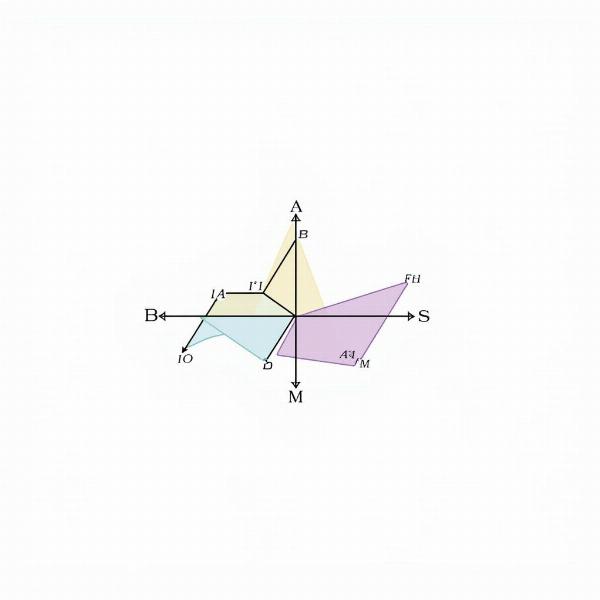Understanding the concept of corresponding angles is crucial in geometry, especially when dealing with parallel lines intersected by a transversal. If you’re looking for the corresponding angle meaning in Hindi, you’ve come to the right place. This article will delve into the definition, properties, and significance of corresponding angles, providing clear explanations and practical examples. We’ll explore how these angles relate to other geometric concepts and why they are essential for various applications.
What are Corresponding Angles?
Corresponding angles are formed when a transversal intersects two or more lines. They are pairs of angles that occupy the same relative position at each intersection. In simpler terms, imagine the transversal creating a “mirror image” of the angles at each intersection. The angles that reflect each other are corresponding angles. The corresponding angle meaning in Hindi can be understood as “संगत कोण” (sangat kon), where “sangat” means corresponding and “kon” means angle.
 Corresponding Angles Diagram
Corresponding Angles Diagram
When the two lines intersected by the transversal are parallel, the corresponding angles are congruent, meaning they have the same measure. This property is fundamental in many geometric proofs and applications. However, if the lines are not parallel, the corresponding angles are not necessarily congruent.
Identifying Corresponding Angles
Identifying corresponding angles can be tricky, especially in complex diagrams. Here’s a simple method:
- Locate the transversal: The line that intersects the other two lines is the transversal.
- Focus on one intersection: Look at the angles formed at one of the intersections.
- Find the matching angle: At the other intersection, locate the angle that occupies the same relative position. For example, if you’re looking at the top left angle at the first intersection, the corresponding angle would be the top left angle at the second intersection.
Corresponding Angles and Parallel Lines
As mentioned earlier, when a transversal intersects two parallel lines, the corresponding angles are congruent. This property is known as the Corresponding Angles Postulate. This postulate is crucial for proving other geometric theorems and solving problems involving parallel lines. For instance, if you know the measure of one corresponding angle, you can automatically determine the measure of the other.
Corresponding Angles in Real-World Applications
The concept of corresponding angles is not just theoretical; it has numerous practical applications in various fields:
- Construction: Architects and engineers use corresponding angles to ensure parallel lines in buildings and bridges.
- Navigation: Sailors and pilots use corresponding angles to determine their course and direction.
- Surveying: Surveyors use corresponding angles to measure land and create maps.
Corresponding Angles vs. Alternate Interior Angles
Corresponding angles and alternate interior angles are often confused. While both are formed when a transversal intersects two lines, they occupy different positions. Alternate interior angles lie between the two lines and on opposite sides of the transversal, whereas corresponding angles are on the same side of the transversal, one interior and one exterior. When the lines are parallel, both corresponding and alternate interior angles are congruent.
Conclusion
Understanding corresponding angle meaning in Hindi (संगत कोण) and their properties is fundamental in geometry. These angles play a crucial role in various applications, from construction and navigation to surveying. Recognizing and applying the concept of corresponding angles can unlock a deeper understanding of geometric principles.
FAQ
- What is the Hindi word for corresponding angles? The Hindi word for corresponding angles is संगत कोण (sangat kon).
- Are corresponding angles always congruent? No, corresponding angles are only congruent when the lines intersected by the transversal are parallel.
- How can I identify corresponding angles? Look for angles that occupy the same relative position at each intersection formed by the transversal.
- What is the Corresponding Angles Postulate? The Corresponding Angles Postulate states that if a transversal intersects two parallel lines, then the corresponding angles are congruent.
- Why are corresponding angles important? Corresponding angles are important for proving geometric theorems and have practical applications in fields like construction, navigation, and surveying.
- What is the difference between corresponding angles and alternate interior angles? Corresponding angles are on the same side of the transversal, one interior and one exterior, while alternate interior angles lie between the two lines and on opposite sides of the transversal.
- Where can I learn more about corresponding angles? You can find more information about corresponding angles in geometry textbooks and online resources.
Meaning-Hindi.in is your one-stop solution for all your Hindi translation needs. We offer a wide range of translation services, including business and commercial document translation, certified and legal document translation, technical and user manual translation, website and localization translation, educational and academic document translation, and fast and specialized translation services. Contact us today at [email protected] or +91 11-4502-7584 for a free quote. Let Meaning-Hindi.in help you bridge the language gap!